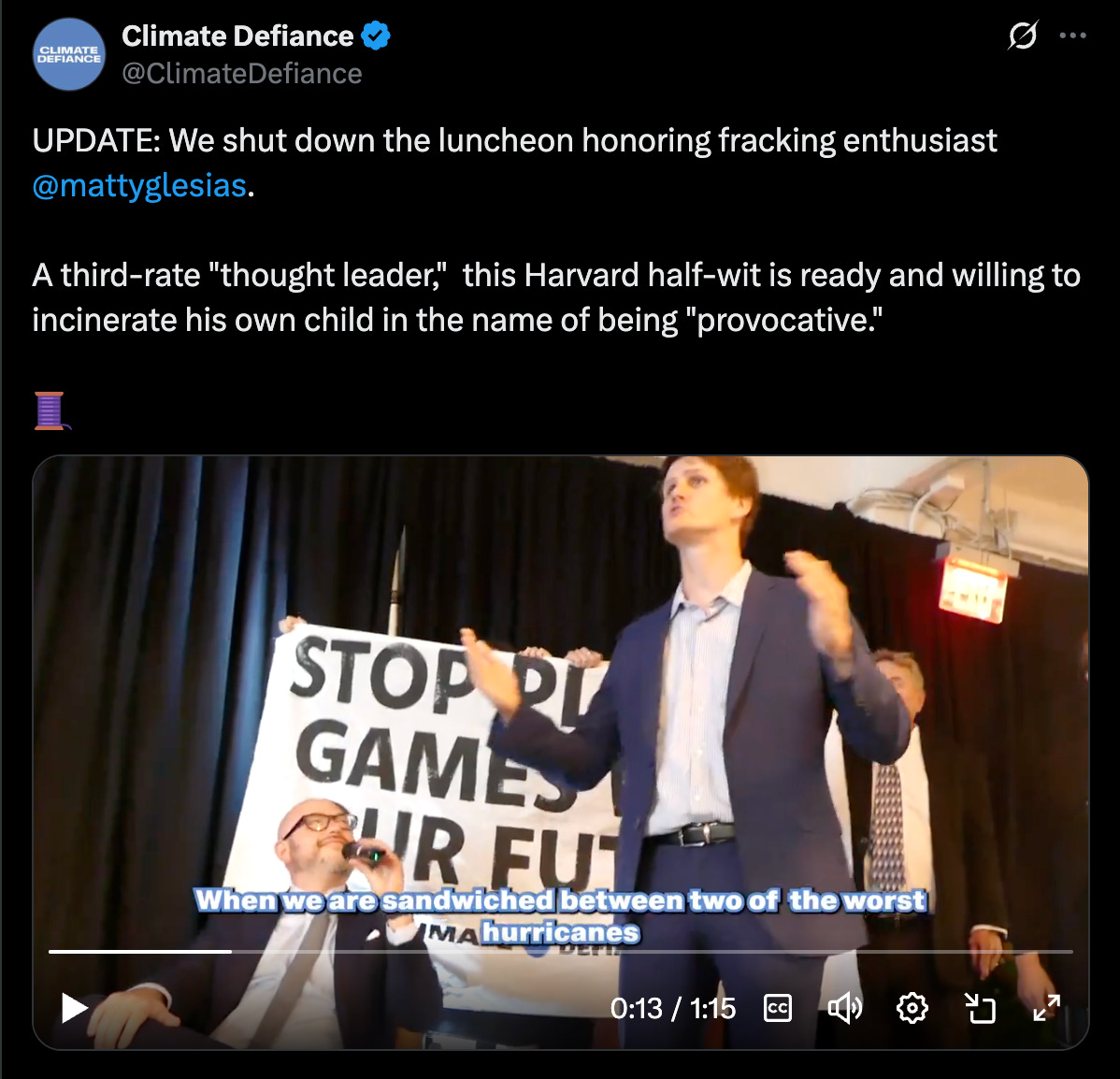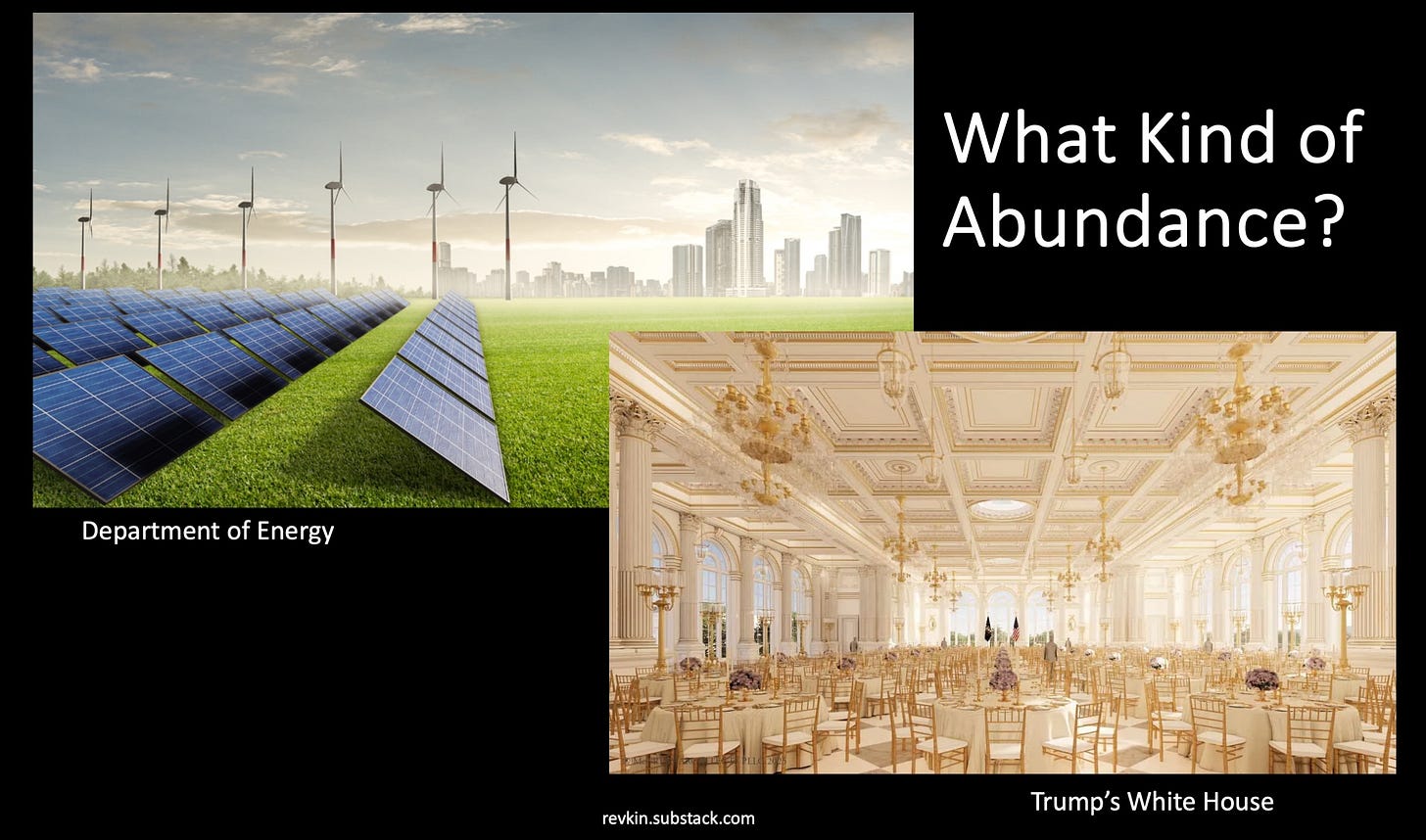The Abundance Challenge: Finding a Sweet Spot Between Degrowth and Trump Ballrooms
In this Sustain What project, I haven’t gotten into the debate (yet) around the
/ Ezra Klein bestseller Abundance or the wider conversation under way at conferences like the inaugural Abundance conclave in Washington D.C. invaded by climate activists last year and the followup Abundance 2025 meeting in September.
On its “mission” page, this year’s conference, featuring a batch of my friends in the ecomodernist wing of society, appropriately didn’t have a mission statement so much as a description of a community with differing politics and theories of change but a common goal:
…a cross-partisan coalition committed to accelerating economic growth, reinforcing American leadership in science and technology, dismantling bureaucratic inertia, restoring effective governance, and reducing the cost of living. Abundance is not an abstract ideal but a moral and civic imperative: to revitalize the nation’s productive base, support working families, and reassert democratic control over technocratic systems.
Read
’s takeaway here for starters. I agree with him that abundance, as articulated, is close to synonymous with growth. (Quite a few adherents frame it in opposition to the dark green “degrowth” movement.) That still leaves a lot of blank space to be filled in on how to shape growth with people and the environment in mind, of course.Are democracy and abundance incompatible?
A successful effort to “reassert democratic control over technocratic systems” could easily derail the energy-abundance agenda, for instance. But in the absence of such governance guardrails, who’s to say that abundance wouldn’t include Trumpian ballrooms?
Happily, the meeting appears to have been as much about spurring conversation around those blank spaces as pushing a specific agenda. As Pielke writes:
[I]t was incredibly refreshing to be alongside 700 others who expressed a commitment to bipartisan cooperation, active debate and discussion, and productive disagreement. Political collegiality, curiosity, and collaboration do seem pretty new in 2025.
Makes me want to go next year.
Pielke criticized efforts to tarnish the meeting and movement by highlighting links to a roster of tech-bro billionaires and their ilk. Such efforts include the Revolving Door Project report on those connections released ahead of the meeting. It does include a fun connection map.
This diagram is a visual display of the research compiled in The Revolving Door Project’s report on the abundance ecosystem.
Like Pielke, I’m more interested in actual ideas, evidence and potential outcomes than who’s paying.
And
of the , who helped organized Abundance 2025 and Abundance 2024, pushed back in his keynote talk there:Abundance is not this astroturfed conspiracy. In fact just the opposite: abundance is emergent. Abundance is bottom-up. We were not herded and orchestrated: we found each other.
The people and ideas in this ballroom pull on strands from multiple fields—think tanks, activists, organizers, elected officials, journalists, philanthropists, technologists and entrepreneurs and investors—and multiple ideological traditions—liberalism (classical and otherwise), urbanism, supply-side progressivism, state capacity libertarianism, industrial conservative populism, ecomodernism, humanism, effective altruism, and beyond. There are, as we learned this morning, many Varieties of Abundance. We’re all here not because we agree on everything that our corporate overlords tell us to believe, but to do the messy work of figuring out what unites us across differences, how we can collaborate to solve real material problems in the world, and whether this audacious thing called Abundance can meaningfully change American politics and culture.
There is no energy transition without abundance
I’m posting on all of this now because of something the clean-energy journalist Stephen Lacey wrote on LinkedIn about abundance. I asked permission to repost it here and you can read his reflection below. I got to know Lacey a decade ago when he helped produce and support Warm Regards, a podcast on climate questions conceived by
and, in the first years, co-hosted by Holthaus, the paleoecologist Jacequelyn Gill and yours truly. I miss those conversations!He’s still at it, lately as executive editor and co-founder of Latitude Media, a news outlet and media production company focused on clean energy and climate technology. There Lacey is also a co-host of the “Open Circuit” podcast.
Here’s Lacey’s quick take:
I’ve been reflecting on why the Abundance narrative resonates so strongly with me.
I’ve always cared deeply about conservation and environmental issues. But I never quite felt like a traditional environmentalist. For a long time, I didn’t know why.
I felt it early. In high school, a teacher encouraged us to attend a community meeting about a nearby nuclear plant. She handed out flyers warning of radioactive danger and urged us to speak as the concerned youth who wanted it shut down.
I barely knew anything about nuclear energy, but the whole thing felt off. It wasn’t that I disagreed — it was that I didn’t know. Taking a side without understanding felt wrong, even then.
The environmental movement has evolved a lot since then, including on nuclear. But that “just say no” instinct still guides big parts of it — and that’s what never resonated with me.
Then in college, something shifted. I was working on a research paper when I picked up the book “Natural Capitalism.” Instead of treating environmental protection as resistance to industry, it argued that efficiency, innovation, and productivity were the real levers of sustainability. It spoke in the language of business and progress.
I’ve been thinking about why that message landed for me. A lot of it comes back to what my parents did for work.
My mom ran a steel fabrication company for three decades. She started as a secretary and eventually led the business through recessions and growth. One expansion? Fabricating steel parts for clean energy projects. On weekends, she’d bring me to the plant. I can still smell the oil and metal, hear the hum of the grinders, see the comics and pin-ups over workstations. That was my introduction to what it takes to literally put steel in the ground.
My dad was a forester, and later a realtor who specialized in land deals. We spent a lot of time in the woods, memorizing species of trees, tracing land boundaries, and talking about the history of the land. He taught me to appreciate nature — but also how to use it through responsible logging, land management, and allowing hunters on our property. It was respectful and practical.
Nearly 20 years ago, I found my calling as a reporter and editor focused on the energy transition. Today, as we take on the greatest infrastructure project in history — decarbonizing the economy — I’m more excited than ever to see what we can build. Flexible data centers. Mines. Transmission. Clean steel plants. Yes, yes, yes.
We’re now in a weird moment. Everyone talks about wanting to build, but it’s harder than ever. It’s been difficult to build infrastructure in blue states because of local opposition. Meanwhile, many on the right who want “energy dominance” are happy to weaponize regulations to stop stuff they don’t like.
I really want my daughter to grow up in a world of abundance — maybe even help build it. I hope she can look back and see the same influence from my work that my parents had on me.
His views resonate powerfully with me and I plan to host him and others in a Sustain What webcast soon to dig deeper.
For LOTS more on abundance, do read
:



